Emerging technologies
Fermilab has long been a pioneer in developing technologies for fundamental science that have tranferred to industry and, today, have profound impact on our everyday lives. The design of Fermilab's Tevatron particle collider, which operated from 1987-2011, drove the commercial production of superconducting wire and cable, creating an infrastructure that made possible the placement of MRI machines that today are commonplace across the world's major hospitals. This effort earned the recognition of the Institute of Electrical and Electronic Engineers in 2017. Back in 1946, Fermilab founding director Robert Wilson, sometimes referred to as the "father of proton therapy," wrote the seminal paper "Radiological Use of Fast Protons," which first suggested the idea of using protons for medical treatment. Wilson's vision came to life when Fermilab designed and constructed the world's first proton accelerator built specifically to administer proton therapy at Loma Linda University Medical Center, where the first patients were treated in 1990.
Fermilab researchers and their partners continue to push the boundaries of science for fundamental discovery, and the results of Fermilab's quest to push the level of science and technology higher benefit all. Fermilab research makes an impact not only on our understanding of the universe, but also on our health, wealth and homeland security.
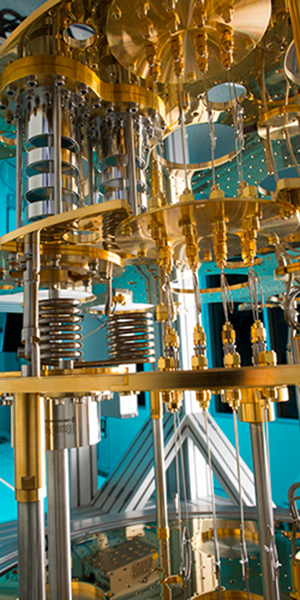
Quantum computing, sensors and algorithms
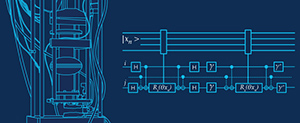
Fermilab leverages the power of quantum science and technology to tackle problems in experimental and theoretical particle physics. Partnering with other institutions, it draws on its world-class expertise in superconducting technology, electronics and controls systems, sensors, and theory and algorithms to advance quantum science and technology and to solve the intractable problems of matter, energy, space and time.
Fermilab is home to the Superconducting Quantum Materials and Systems Center, or SQMS, which brings together national laboratories, academia and industry to make revolutionary advances in quantum computing and sensing, including the building and deployment of a beyond-the-state-of-the-art quantum computer. The quantum devices developed at SQMS will have game-changing impacts in basic science and in our everyday lives. The driving mission of SQMS is to overcome the biggest barrier to the construction of a quantum computer: the short lifetime of the information that lives in a qubit, the basic element of a quantum computer that holds quantum information. SQMS researchers aim to design and fabricate qubits whose coherence times are at least 10 times longer than currently possible.
Outside SQMS, the Fermilab Quantum Institute, launched in 2019, brings other quantum projects together and engages in various partnerships.
Quantum internet and networks
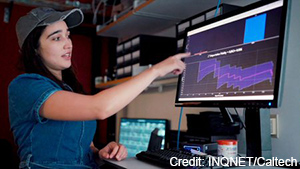
Quantum networks and a connected quantum internet have the potential to bring new capabilities and enable new applications beyond what can be achieved with classical networks, such as distributed secure communication and national security. Other transformational applications involve distributed quantum sensing and connecting quantum computers, enabling tasks beyond what can be achieved with classical means, all the way to fully distributed quantum computing.
Fermilab and its partners have been working to advance the technologies and architectures necessary to realize a vision for a quantum internet.
Fermilab is a founding member of the Intelligent Quantum Networks and Technologies consortium, or INQNET, which aims to achieve the fidelity and operational robustness required for quantum network applications beyond the "demonstrator" stage. Using our Caltech Quantum Network and Fermilab Quantum Network testbeds, a Caltech-led collaboration (with Fermilab, AT&T, Harvard University, NASA's Jet Propulsion Laboratory, and the University of Calgary) has achieved sustained, high-fidelity quantum teleportation over fiber optics cables, the same type of fibers used by the telecommunication industry today.
The Illinois Express Quantum Network builds on and leverages the technologies and systems developed by CQNET and FQNET to realize point-to-point communications and, eventually, to deploy a fully dynamic metropolitan-scale network with multiple nodes that support multiple users. This would be a demonstration of the operation of repeaterless transparent optical quantum network designs in the greater Chicago metropolitan area, leveraging existing network infrastructure. IEQNET, led by Fermilab, includes Argonne National Laboratory, Northwestern University, and Caltech, as well as small businesses (NuCrypt, HyperLight) and the INQNET AT&T/Caltech consortium.
Artificial intelligence and machine learning
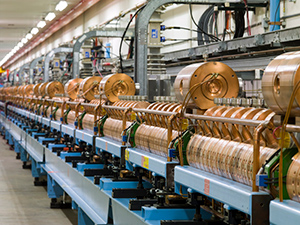
Massive and rich data sets, advanced particle accelerators, some of the world's most complex detector systems: Tech developments at Fermilab have potential connections to a rich and broad domain of cutting-edge AI research.
Through its Artificial Intelligence Project, Fermilab aims to boost high-energy physics research, develop AI capabilities that build on high-energy physics challenges and technologies, and build an international community around cross-cutting problems in high-energy physics.
Fermilab is developing and deploying AI algorithms to improve physics measurements and searches to fulfill our scientific mission. Its AI research provides opportunities to build novel algorithms to address complex scientific data, including in cosmology, neutrino research, high-energy collider physics and beyond; solve big-data computing hardware and infrastructure challenges; apply AI algorithms to bring astronomy research into the big-data era; embed AI into sensors and experimental design in extreme environments; develop operations and controls using AI techniques; and use quantum data in machine learning applications.
Scientists are developing machine learning frameworks able to monitor a speed-of-light particle beam in real time, leading to improved beam quality and reduced beam loss. Machine learning programs code, embedded into the control electronics, will be able to will be able to measure and respond to beam data within milliseconds. These machine learning techniques will bring new and unique capabilities to accelerator facilities everywhere.
Read more | Download fact sheet (pdf)
Strategic accelerator R&D
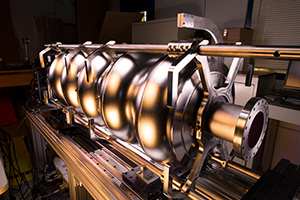
Fermilab is a world leader in particle accelerator science and technology and an essential contributor to present and future large accelerators across the DOE complex and around the world. It works with national and international partners to design and build accelerators that enable scientists to probe nature with incredible precision.
Fermilab is a world leader in the design and construction of superconducting accelerator cavities, instruments that impart energy to particle beams. The energy efficiency of these structures benefits a range of scientific initiatives, including medicine, the environment, quantum science and technology, and basic science. Fermilab cavity R&D focuses on dramatic improvements of cavity performance, cutting costs, and improving understanding of the underlying physics and materials science.
Fermilab is also an innovator in accelerator magnet design and fabrication. Magnets of immense strength are required for future high-energy particle colliders, such as the proposed Future Circular Collider. Researchers are developing new magnet technologies and materials required for the next generation of particle accelerators. Scientists and engineers are also developing advanced superconducting undulators — magnets that "wiggle" particle beams so that the beams radiate light rays, such as X-rays. Fermilab is working to enable unprecedented hard X-ray reach in next-generation X-ray free-electron lasers, significantly improve undulator performance and reduce their cost.
High-power targetry is essential to DOE's future. Equipped with targets that can withstand powerful particle beams, accelerators will be able to generate rare particles critical to future particle physics experiments. Materials and technologies that are resilient to these harsh environments are needed to enable multimegawatt target facility operation.
Researchers at Fermilab are also investigating the physics of the particle beam itself. They operate modern accelerator test facilities to perform advanced beam physics, develop novel beam dynamics techniques and demonstrate state-of-the-art technologies.
Exascale data storage and access
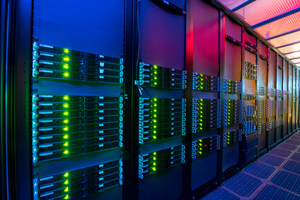 High-energy physics has some of the world's largest data sets and, therefore, some of the world's largest computing challenges. The next generation of high-energy physics experiments will produce data sets as large as exabytes — or millions of terabytes. Fermilab world-class mass storage capability, currently hundreds of petabytes, is being expanded to handle exabyte-sized data sets. At the same time, Fermilab is working with experiments to adapt current experiment software to run on upcoming leadership-class exabyte computers. At the same time, Fermilab is working with experiments to adapt current experiment software to run on upcoming leadership-class exabyte computers. It is also adapting data transfers and workflows to bring together Fermilab's mass storage and computing facility with upcoming exascale computing capabilities.
High-energy physics has some of the world's largest data sets and, therefore, some of the world's largest computing challenges. The next generation of high-energy physics experiments will produce data sets as large as exabytes — or millions of terabytes. Fermilab world-class mass storage capability, currently hundreds of petabytes, is being expanded to handle exabyte-sized data sets. At the same time, Fermilab is working with experiments to adapt current experiment software to run on upcoming leadership-class exabyte computers. At the same time, Fermilab is working with experiments to adapt current experiment software to run on upcoming leadership-class exabyte computers. It is also adapting data transfers and workflows to bring together Fermilab's mass storage and computing facility with upcoming exascale computing capabilities.
Microelectronics
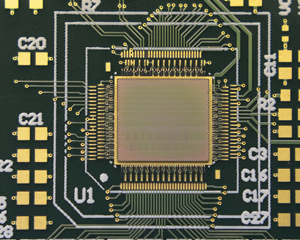
Fermilab has been leading the design of large-area detectors for high-energy physics for over three decades. These detectors meet demanding requirements: They must operate reliably over the lifetime of the experiment in compact geometries and resource-constrained extreme environments, such as cryogenic temperatures. Researchers' efforts have led to the development of custom microelectronics with complex in-pixel processing and reconfigurable data-driven architectures, enabling edge computing and the ability to dramatically winnow particle events to the most important data.
Over the last decade, Fermilab has successfully applied the concepts developed for high-energy physics to other areas such as X-ray detectors for synchrotron sources and free-electron lasers. It is now developing deep cryogenic electronics for quantum systems, as well as on-chip machine learning for on-detector data processing.
- Last modified
- 02/25/21
- email Fermilab

